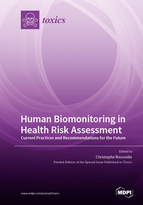Human Biomonitoring in Health Risk Assessment: Current Practices and Recommendations for the Future
A special issue of Toxics (ISSN 2305-6304). This special issue belongs to the section "Exposome Analysis and Risk Assessment".
Deadline for manuscript submissions: closed (20 October 2022) | Viewed by 42894
Special Issue Editor
Interests: chemical risk assessment in a regulatory context; endocrine disrupters; cosmetic products; reach, derivation of health-based guidance values (either for general population or for workers); biomonitoring data in risk assessments
Special Issue Information
Dear Colleagues,
In most health risk assessment (HRA) frameworks for chemicals, the default approach for exposure assessment is to estimate intake from different sources and different routes of exposure. These assessments are often made separately and then added when aggregate exposure scenarios are considered. Various uncertainties are associated with this approach and, depending on the scope of the assessment; it may over- or under-estimate the internal exposure. Human Biomonitoring (HBM) is an important and useful tool for assessing the internal exposure of humans resulting from aggregated exposure to chemicals. HBM can also provide a better estimate of exposure closed to the target organ. Inclusion of HBM data could improve HRA for the general population and for workers. Though there are still a number of obstacles that hinder the use of HBM data in a HRA, the growing availability of HBM data offers an opportunity for improving and refining RA.
This Special Issue intends to illustrate, using case studies, how HBM data can be used to better estimate internal exposure and resulting risks. Case studies either on exposure from the use of consumer products (cosmetic products, non-food products, etc.) or from exposures via food or water, in the general population or among workers, will contribute to better identifying the hurdles that prevent a broader use of HBM data in RA. New tools such as physiologically-based pharmacokinetic (PBPK) models, derivations of health-based guidance values, new approaches for integrating HBM with in vitro/in silico data, and adverse outcome pathways (AOP), by providing more accurate data on actual internal exposure, could improve HRA. The articles in this Special Issue are expected to give recommendations on the most suitable approaches for generating more reliable HRA.
Dr. Christophe Rousselle
Guest Editor
Manuscript Submission Information
Manuscripts should be submitted online at www.mdpi.com by registering and logging in to this website. Once you are registered, click here to go to the submission form. Manuscripts can be submitted until the deadline. All submissions that pass pre-check are peer-reviewed. Accepted papers will be published continuously in the journal (as soon as accepted) and will be listed together on the special issue website. Research articles, review articles as well as short communications are invited. For planned papers, a title and short abstract (about 100 words) can be sent to the Editorial Office for announcement on this website.
Submitted manuscripts should not have been published previously, nor be under consideration for publication elsewhere (except conference proceedings papers). All manuscripts are thoroughly refereed through a single-blind peer-review process. A guide for authors and other relevant information for submission of manuscripts is available on the Instructions for Authors page. Toxics is an international peer-reviewed open access monthly journal published by MDPI.
Please visit the Instructions for Authors page before submitting a manuscript. The Article Processing Charge (APC) for publication in this open access journal is 2600 CHF (Swiss Francs). Submitted papers should be well formatted and use good English. Authors may use MDPI's English editing service prior to publication or during author revisions.
Keywords
- human biomonitoring
- risk assessment
- internal exposure
- aggregated exposure
- guidance values
- prioritization
- mixtures







